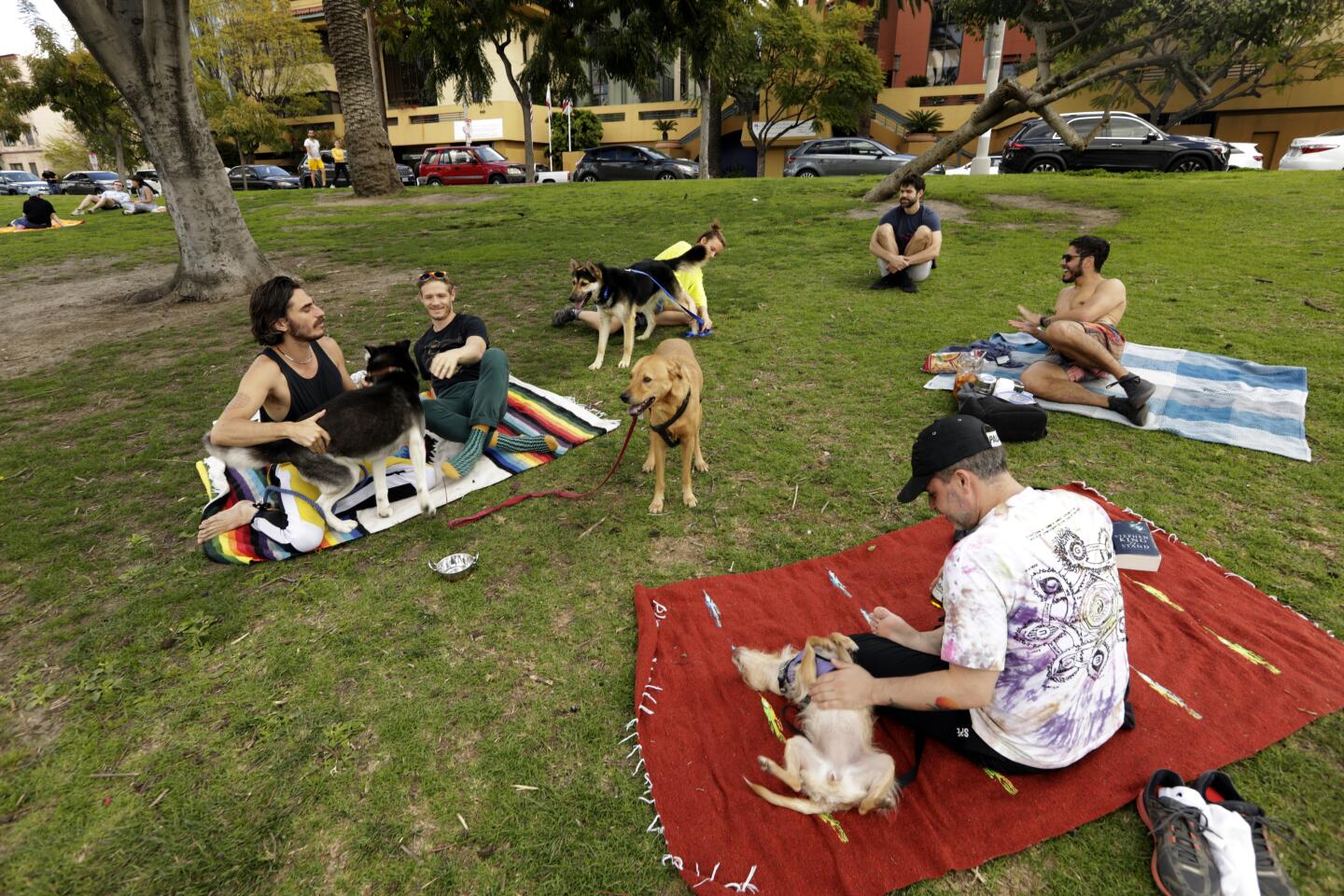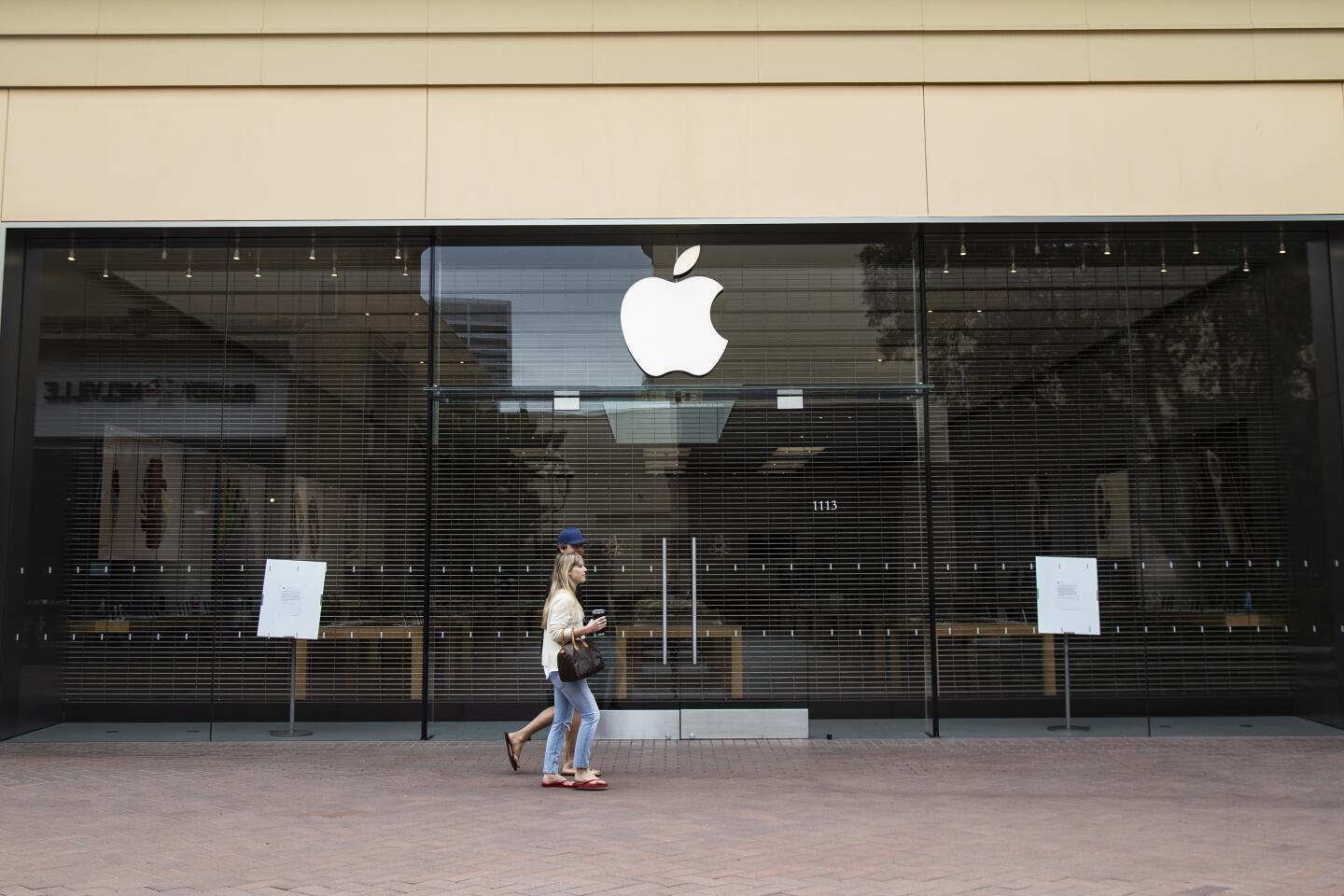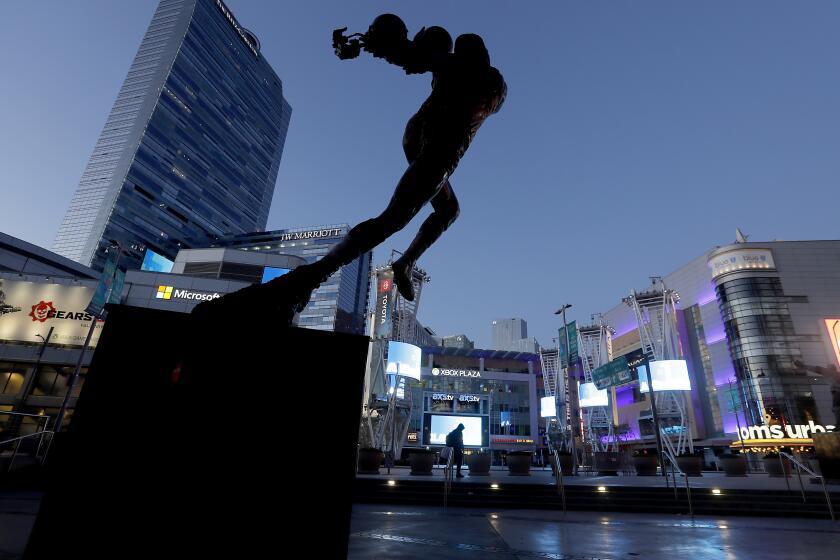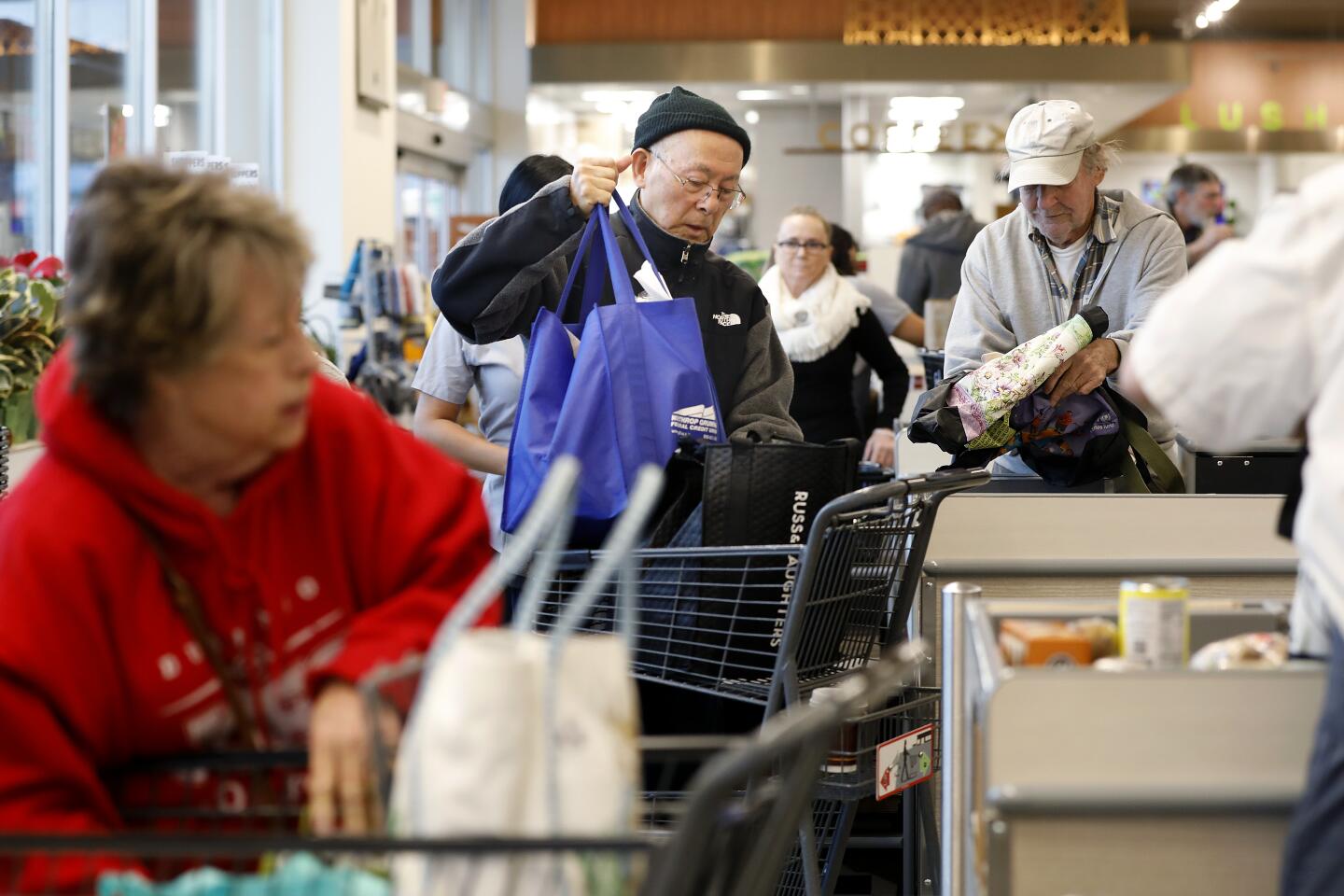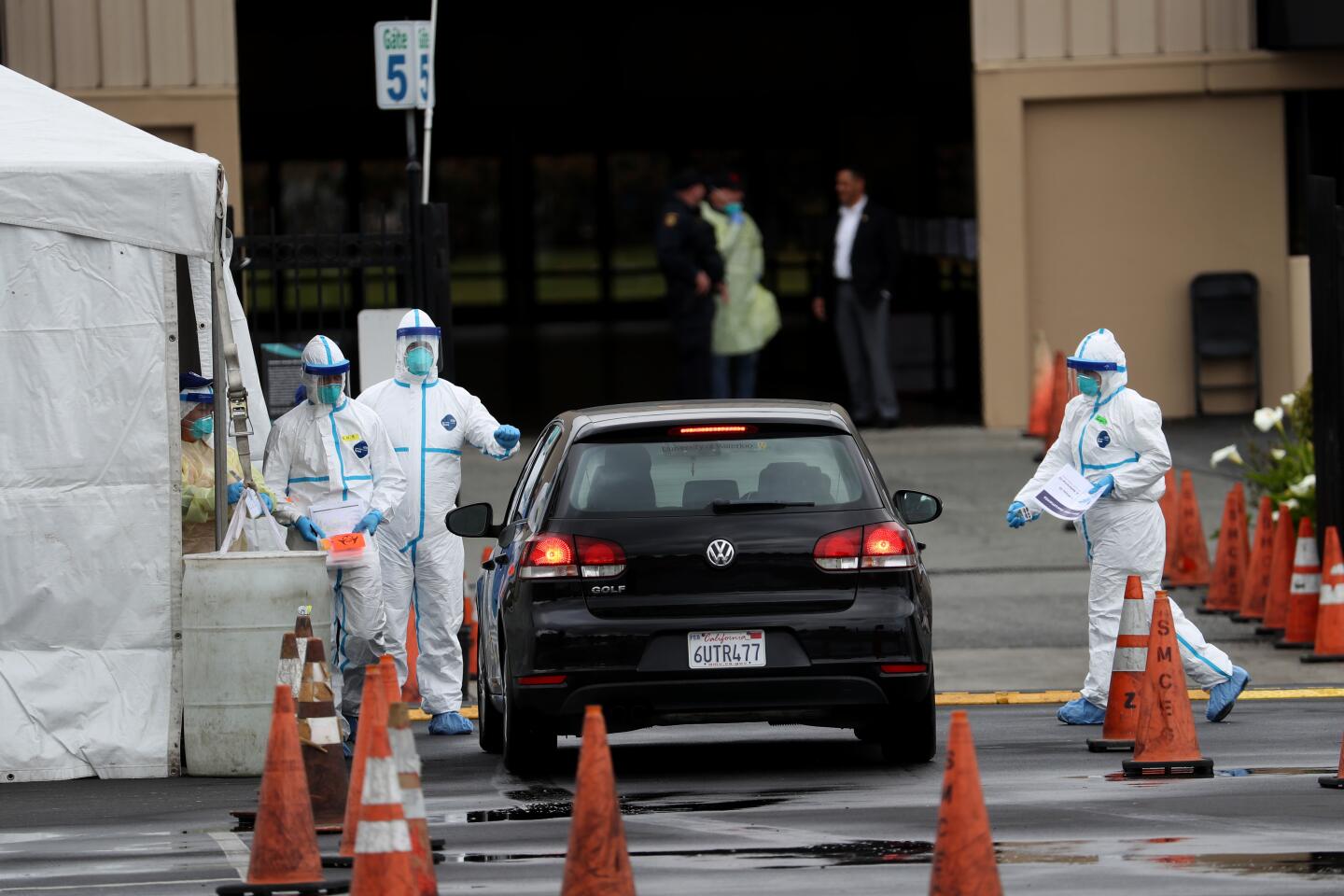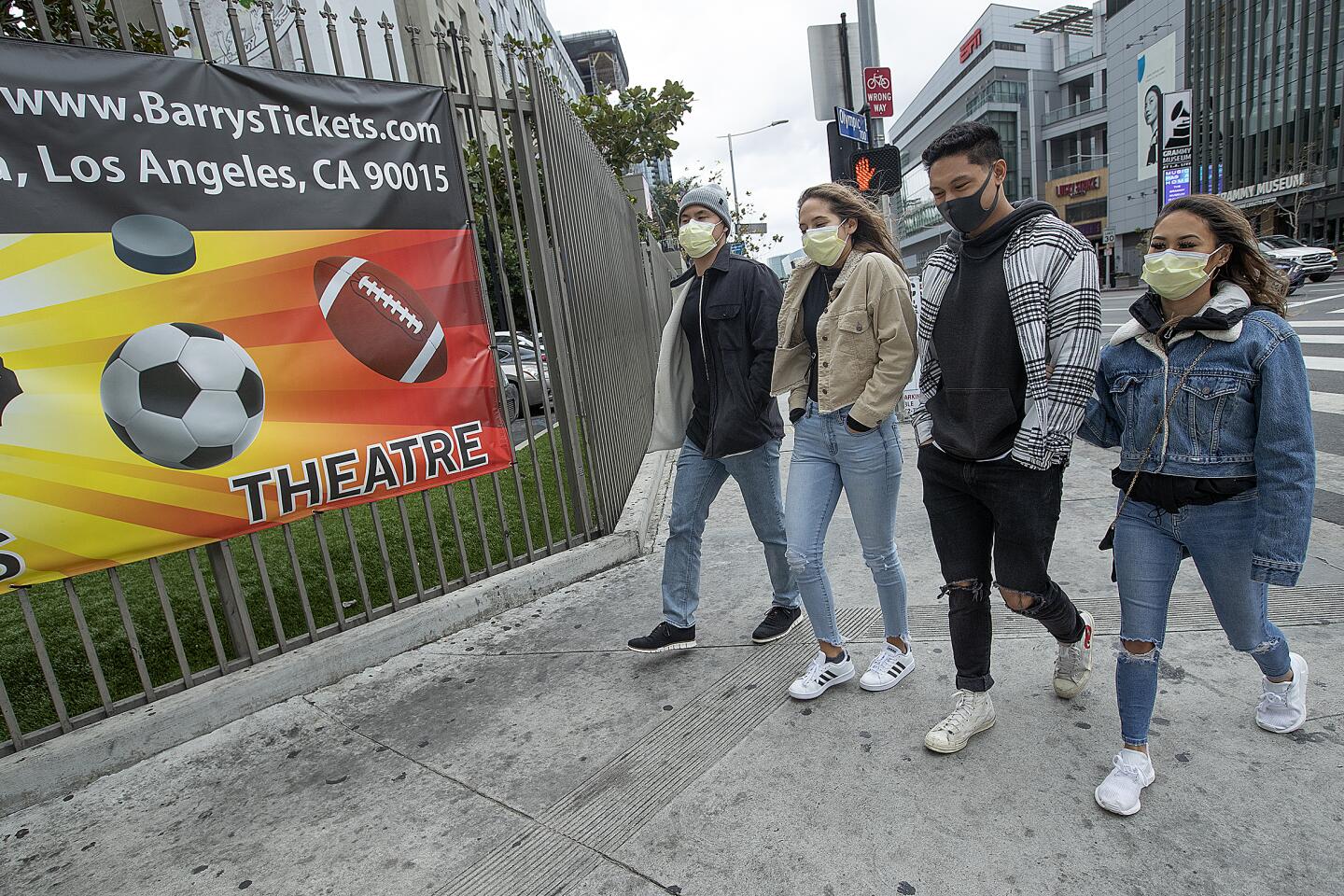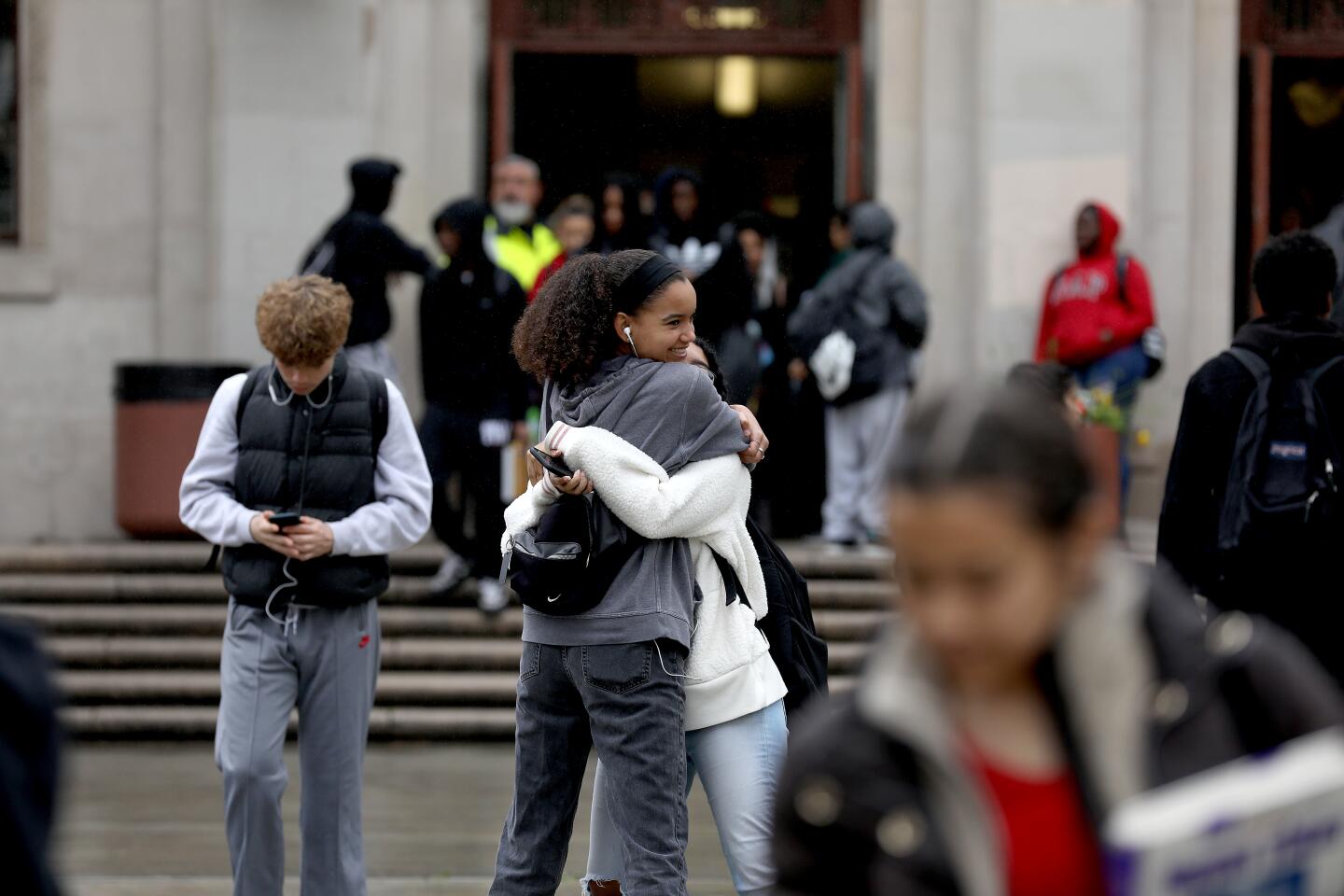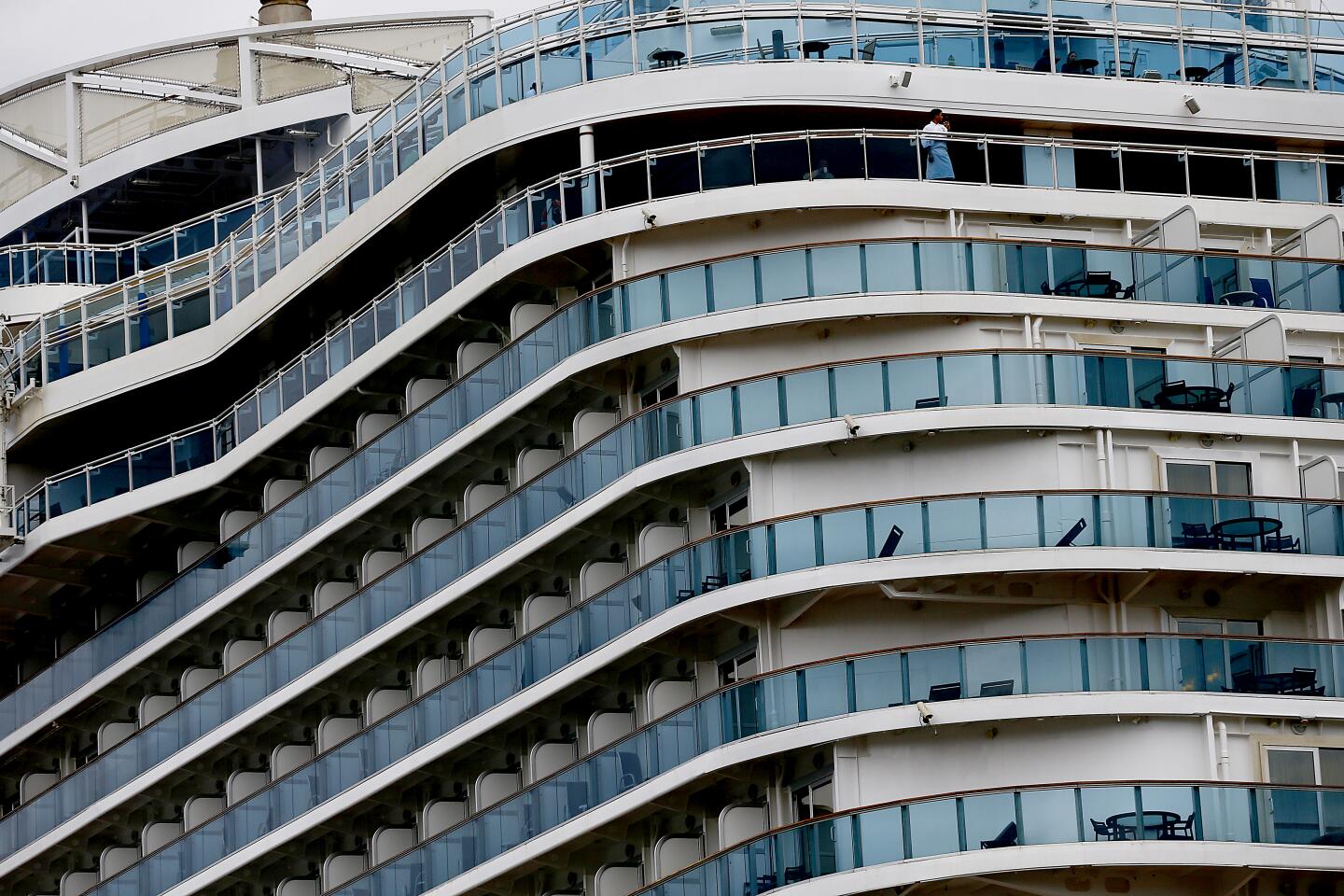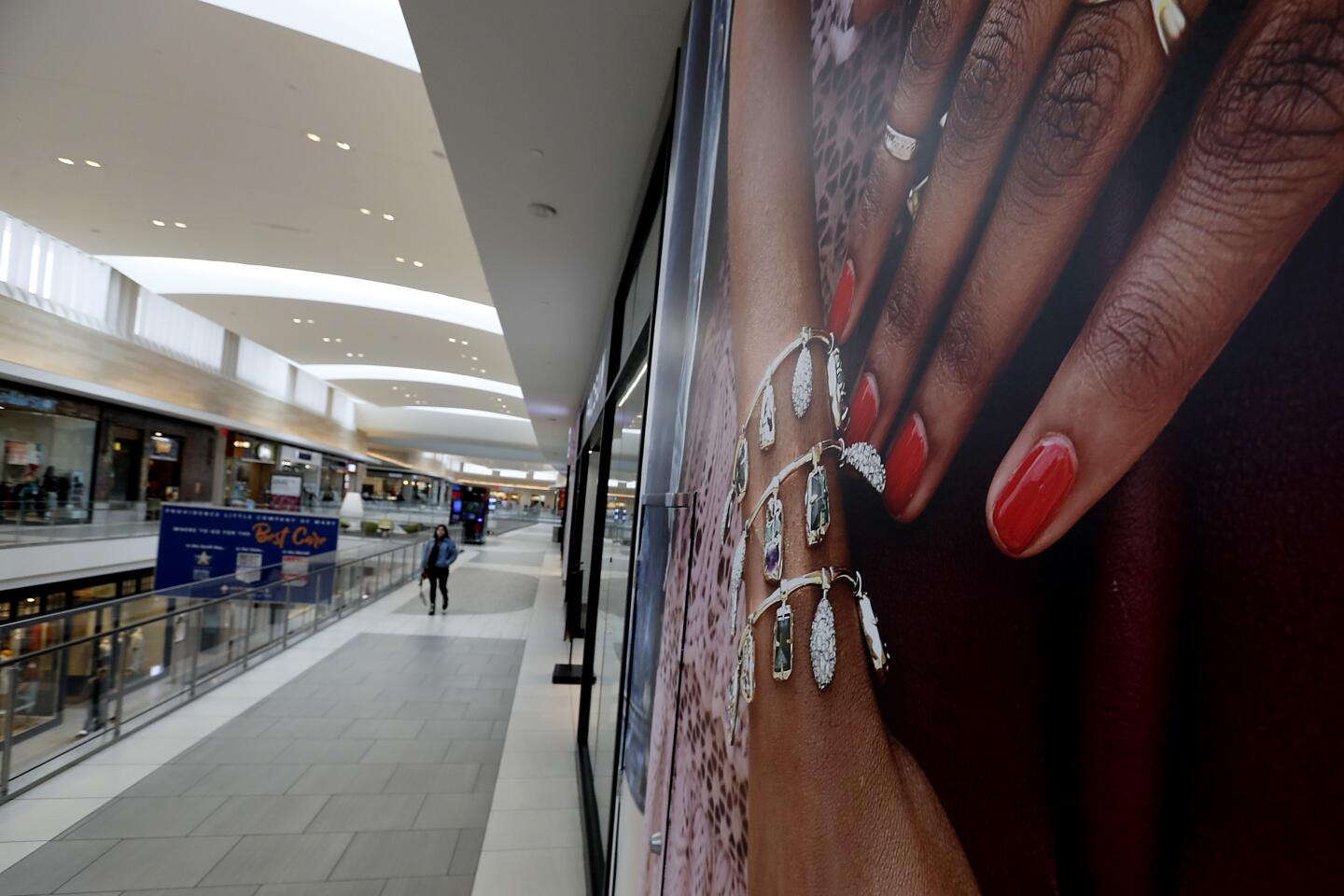L.A. County confirms 61 new coronavirus cases, says median age among all patients is 47

One day after Gov. Gavin Newsom announced extraordinary measures directing all Californians to stay at home amid the coronavirus outbreak, Los Angeles County confirmed 61 new coronavirus cases, including 12 people in Long Beach and two in Pasadena. The new cases bring the county’s total to 292 amid the growing outbreak.
The median age for the total of those who have been infected is 47, county Public Health Department Director Dr. Barbara Ferrer said. There are 138 people between the ages of 18 and 65 who have tested positive.
“The risk is spread across everyone,” Ferrer said at a briefing Friday.
So far, about 2,400 people have been tested in L.A. County. Roughly 10% of those have tested positive, health officials said.
Asked why someone would be denied testing for the coronavirus and who ultimately makes the decision in L.A. County, Ferrer said an individual would need to go to a medical provider, who would then authorize a test.
“Don’t go to a hospital to get tested,” she said.
Officials also announced that the Sheraton Fairplex in Pomona will serve those who need to be quarantined. More than 200 rooms will be available for people who will be provided space on a first-come, first-served basis. Individuals who have tested positive for the virus, are showing symptoms or have been exposed to someone with the virus will be given priority.
Additional deaths were reported Friday across the state. Contra Costa County announced its first death related to the virus: a person in their 70s who had an underlying medical condition and had recently traveled to Europe. The patient died Thursday in an undisclosed hospital.
Gov. Gavin Newsom has ordered Californians to stay at home. With businesses and popular destinations closed, The Times’ Luis Sinco documented the surreal scenes.
And Riverside County reported its fourth death, the 21st in California since the coronavirus outbreak began. Information about the person who died wasn’t immediately available.
Santa Clara County announced two additional deaths from COVID-19 on Friday, bringing its total to eight.
The number of reported cases continues to rise across the state. The California Department of Corrections and Rehabilitation confirmed Friday that an employee at California State Prison in Sacramento and an employee at San Quentin State Prison have both tested positive for COVID-19, the illness caused by the virus. But the agency said there are no confirmed cases among inmates.
Some 1,800 prisoners at San Quentin have been on lockdown most of the week after several inmates developed flu-like symptoms. The Corrections Department has not released the results of testing of those, or any other, prison inmates.
In Irvine, a firefighter at Station 4 tested positive for the coronavirus, leading the Orange County Fire Authority to place 24 additional firefighters with whom he had contact in self-isolation.
The firefighter had no known contact with a positive individual and is already feeling better, Fire Chief Brian Fennessy said.
Having 25 firefighters out could impact the department, but should not have a huge effect on a department of 1,100, Fennessy said.
Retailers are setting aside time for seniors and other vulnerable populations to do their shopping in a less-crowded environment.
A veteran tested positive at the West Los Angeles Veterans Affairs Medical Center on Wednesday. The person, who was admitted after coming into the emergency room, is being cared for in isolation, and the risk of transmission to other patients and staff is low, said Steve Ruh, chief of communications for the VA Greater L.A. Healthcare System. The VA is screening veterans and staffers and isolating those found to be at risk, Ruh said.
In San Diego County, a third cluster of COVID-19 patients was announced Thursday, as the local count of virus cases jumped from 80 to 105 and efforts to house vulnerable people in local hotels progressed.
To deal with a possible surge in coronavirus patients, the state plans to lease beds at a Northern California hospital and skilled nursing facility that were facing closure. California will lease the 357-bed Seton Medical Center in Daly City and 116-bed Seton Coastside in Moss Beach, the National Union of Healthcare Workers said in a news release.
In the meantime, Yosemite National Park shut down to all visitors on Friday. No access to the park will be permitted until further notice.
Amid the continuing spread, Newsom on Thursday ordered Californians to stay at home, marking the first mandatory restrictions placed on the lives of all 40 million residents in the state’s fight against the novel coronavirus.
Top federal officials applauded the decision at a White House press briefing Friday.
Dr. Anthony Fauci, director of the National Institute of Allergy and Infectious Diseases, said that he “strongly” supported the move by Newsom, as well as a similar directive by New York Gov. Andrew Cuomo, and urged residents of the two hard-hit states to heed the new orders.
President Trump also praised Newsom and Cuomo, saying, “I applaud them” for “taking very bold steps” to limit activities in their states.
Newsom’s action comes at a critical time in California, where more than 1,000 people have tested positive for the disease, and it appeared to be the most far-reaching directive of any issued by states battling the epidemic.
The mandatory order allows Californians to continue to visit gas stations, pharmacies, grocery stores, farmers markets, food banks, convenience stores, takeout and delivery restaurants, banks and laundromats. People can leave their homes to care for a relative or a friend or seek healthcare services.
It exempts workers in 16 federal critical infrastructure sectors, including food and agriculture, healthcare, transportation, energy, financial services, emergency response and others.
Newsom asked Californians to practice social distancing when performing such “necessary activities.”
“We’re going to keep the grocery stores open,” he said. “We’re going to make sure that you’re getting critical medical supplies. You can still take your kids outside, practicing common sense and social distancing. You can still walk your dog.”
Coronavirus: Here are the rules now that Newsom has ordered all Californians to stay at home
No time frame was set for when the order would end. It was unclear exactly how far the order would reach in communities where some operations, such as schools, have not been closed down.
Officials hope telling people to stay home and restrict social interactions will slow the spread of the virus and ultimately prevent hospitals from being overrun with sick patients. The demand of all residents to stay at home marks the strongest escalation of the Newsom administration’s response to the virus and an unprecedented action in modern California history.
“A state as large as ours, a nation-state, is many parts, but at the end of the day, we’re one body. There’s a mutuality, there’s a recognition of our interdependence that requires of this moment that we direct a statewide order for people to stay at home,” Newsom said. “That directive goes into force and effect this evening and we are confident that the people of the state of California will abide by it, will do the right thing.”
Those who don’t abide by the order, administration officials said, could be subject to a misdemeanor citation.
Ventura County issued its own “stay well at home” order Friday, with certain exceptions for essential activities.
Like Newsom’s mandatory statewide stay-at-home order, the Ventura County order emphasizes that people may leave their homes to exercise. The Ventura County order is more specific, however, and says residents can engage in physical activity by themselves or with members of their household, such as walking, running, bicycling or working around their places of residence, including gardening, but they should keep six feet away from anyone outside of their household.
The order prohibits all travel except for essential reasons, such as caring for family or household members, obtaining medical supplies or visiting a healthcare professional, or obtaining food.
Those working for healthcare operations or essential infrastructure, such as utilities, military bases, roads and highways and those constructing housing, are exempt.
And the city of Los Angeles issued its own restrictive order, requiring all nonessential businesses to close, with companies able to operate only through work-at-home arrangements. The order also bans all public gatherings of any size outside homes.
“All businesses, including museums, malls, retail stores, for-profit companies and nonprofit organizations, must stop operations that require workers to be present in person,” Mayor Eric Garcetti said. “No public and private gatherings of any size that would occur outside of a single home will be allowed, with clear exceptions.”
The latest updates from our reporters in California and around the world
Garcetti said residents should leave home only for essential activities and needs, including getting food; caring for a relative, friend or child; getting necessary healthcare; or going for a walk in the neighborhood.
The extraordinary action comes as Newsom offered a grim projection about the toll the novel coronavirus might take on California. He asked Congress on Thursday for $1 billion in federal funds to support the state’s medical response to COVID-19, which he said he expects will infect more than half of all Californians.
The state projects that 25.5 million people in California will be infected over an eight-week period, Newsom said in a letter sent to Trump on Wednesday requesting the deployment of the U.S. Navy’s Mercy hospital ship to the Port of Los Angeles through Sept. 1.
In a separate letter sent to the leaders of the U.S. Senate and House of Representatives, Newsom said the financial aid is crucial to the state’s ability to procure ventilators and other medical supplies, activate state-run hospitals, deploy mobile hospitals and meet other healthcare needs.
“The economic disruption caused by this public health crisis will have immediate and devastating effects on our entire country, including too many families in California,” Newsom wrote. “The magnitude of this crisis is extraordinary and federal-state-local government coordination will be more critical than ever before.”
Gov. Gavin Newsom sent a letter to President Trump on March 19 seeking assistance with the fight against coronavirus.
The governor’s office declined to provide to The Times an explanation of the state’s projection that 25.5 million Californians will be infected with this virus. Instead, a spokesman for the governor said the state’s mitigation efforts could lower that estimate.
“Gov. Newsom has been honest about the threat of the virus and its impact on the health and welfare of Californians,” said Nathan Click, a spokesman for Newsom. “This projection shows why it’s so critical that Californians take action to slow the spread of the disease — and those mitigation efforts aren’t taken into account in those numbers. The state is deploying every resource at its disposal to meet this challenge, and we continue to ask for the federal government’s assistance in this fight.”
In a briefing Wednesday, the governor said the Navy hospital ship and two mobile hospitals would help the state care for an anticipated surge in patients. The governor said the state would need roughly 20,000 more beds if more than half of Californians come down with the coronavirus.
“That’s just one scenario plan. There’s others that are more modest. Some may, some cases [may] be more extreme,” Newsom said. “When you’re looking at getting an additional [19,000] to 20,000 beds in your system, you have to look at your existing surge capacity within the healthcare delivery system, and you have to look at procuring additional assets.”
The governor’s secretary of health and human services, Dr. Mark Ghaly, offered only a brief explanation Thursday of the methodology that went into the state’s projection of 25.5 million infected Californians, saying it was arrived at in consultation with the U.S. Centers for Disease Control and Prevention and was developed a few weeks ago.
“We feel like we are well prepared because of that planning,” Ghaly said.
The tens of millions of COVID-19 cases the Newsom administration is modeling represent an exponentially faster rate of spread than has been seen in other countries. Worldwide, there are about 245,000 confirmed cases of coronavirus infections since the outbreak began late last year.
Though testing in California and the United States is still in its beginning phases, reaching 25.5 million positives in eight weeks would exceed even Italy’s rate of infection, where about 600 people per each 1 million have tested positive, though that rate is still in flux.
Retailers are setting aside time for seniors and other vulnerable populations to do their shopping in a less-crowded environment.
Dr. Karen Smith, a communicable disease expert and former director of the California Department of Public Health, said it’s difficult to determine how many people will be infected with the virus that causes COVID-19 because so much remains unknown about the novel coronavirus.
But Smith, who is advising the response to the pandemic in Santa Clara and Mendocino counties, said the virus is spreading so rapidly that it’s time for Newsom to mandate statewide closures of businesses that go beyond actions some counties have taken.
Before Thursday, Newsom had recommended that bars, restaurant dining rooms and other businesses shutter and left legal orders up to the discretion of county officials, who he has argued are in the best position to determine the appropriate response in their communities.
Smith said the patchwork approach no longer works at this stage in the fight against the virus.
“I personally think that it will be more effective if it is done statewide than if it is done county by county,” Smith said. “There are some counties that aren’t doing anything, but it’s going to leak and it’s going to leak faster if the mitigation stops at some arbitrary boundary.”
She said even some counties that have adopted mandatory closures are allowing too many types of businesses to stay open. Absent mandatory requirements, she said, residents aren’t taking recommendations seriously enough.
“One way to get their attention is to mandate that all of those businesses close and they stay home,” Smith said. “It’s hard and it’s going to hurt people and it’s going to hurt our most vulnerable people a lot, but so will not doing anything. This is unprecedented, and it takes a long time for people to really get it.”
The governor’s request for additional federal funds came three days after lawmakers at the state Capitol approved a plan to spend as much as $1 billion on the state’s emergency medical response to the pandemic in anticipation of a surge in sick patients.
The Democratic governor also requested an expansion of unemployment insurance benefits beyond the 26-week maximum and more funding for Medicaid, federal food assistance, housing and homelessness, state-subsidized early learning and child care and several other safety net programs.
Newsom’s letter to Congress called for support for small businesses, including rental assistance, zero-interest loans and direct cash assistance, and the creation of a new U.S. Treasury Authority to provide guaranteed loans.
Here’s a visual look at how life in Southern California has changed during the coronavirus crisis.
With many schools closed across the state and teachers struggling to implement online and alternative learning programs, the governor also asked for an expansion of technology investments for schools, an increase in Title I funding for schools with a high concentration of poverty, broadband internet upgrades, grants for teachers to adapt to digital-age instruction and more money for the U.S. Department of Agriculture Child Nutrition Programs.
“The challenges we face as elected leaders in this crisis are immense,” Newsom wrote. “Working together, I am confident that we can meet this moment and take the necessary and immediate steps to address our economic and societal needs as we continue to address — and begin to recover from — this unprecedented crisis.”
Times staff writers John Myers, Anita Chabria, Matt Stiles, Soumya Karlamangla and Emily Baumgaertner contributed to this report.
More to Read
Sign up for Essential California
The most important California stories and recommendations in your inbox every morning.
You may occasionally receive promotional content from the Los Angeles Times.

